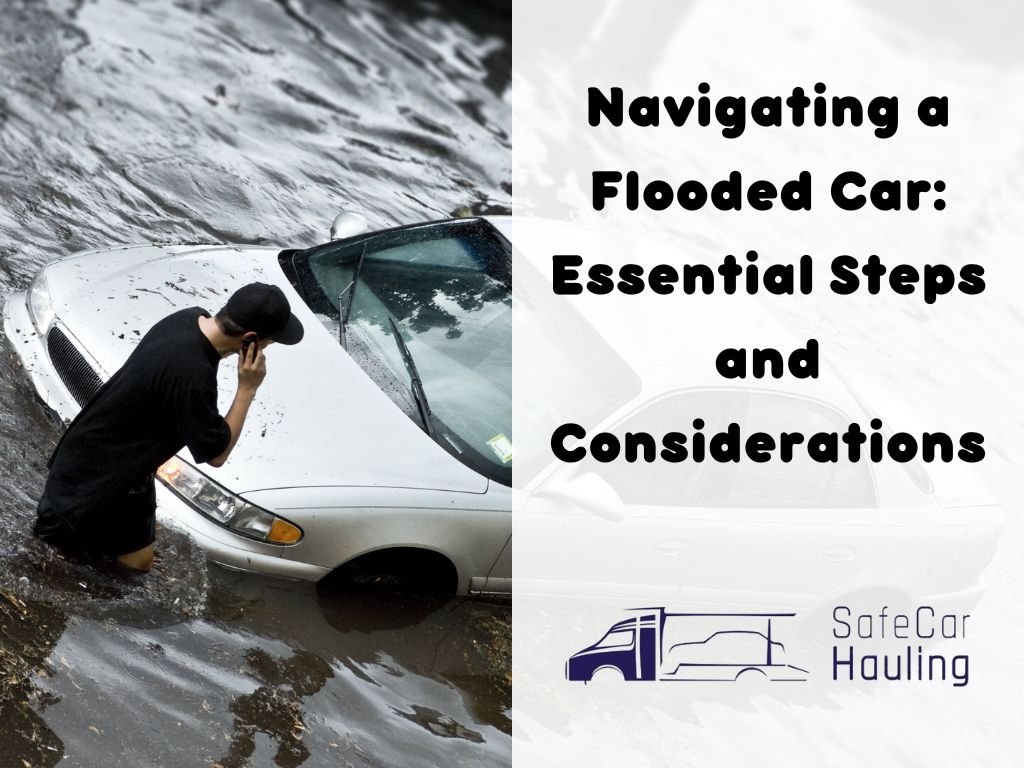Encountering a flooded car can be a distressing experience, but knowing how to respond promptly and effectively can make all the difference in minimizing damage and ensuring safety. In this comprehensive guide, we’ll walk you through the essential steps and considerations for dealing with a flooded vehicle, from initial response to preventative measures for the future.
Get a car shipping quote in seconds!
Instant QuoteI. Initial Response and Safety Measures
Upon discovering a flooded vehicle, it’s crucial to act swiftly while prioritizing personal safety above all else. Here are the immediate actions to take and safety measures to implement:
A. Immediate Actions:
- Turn off the ignition and disconnect the battery to prevent electrical hazards.
- Check for occupants and ensure their safety before proceeding with any assessment.
- If the car is submerged, avoid attempting to start the engine or drive the vehicle out of the water.
B. Safety Measures:
- Exercise caution when wading through floodwaters, as they may contain debris or hidden hazards.
- Wear protective gear such as rubber boots and gloves to minimize exposure to contaminated water.
- Avoid contact with electrical components and wiring to prevent the risk of electric shock.
II. Assessing the Damage
A thorough inspection of both the exterior and interior of the flooded car is necessary to gauge the extent of water damage. Here’s how to assess the damage effectively:
A. Exterior Inspection:
- Check for signs of water entry, such as water lines and debris accumulation on the exterior surfaces.
- Inspect the undercarriage for mud, silt, or debris, which may indicate submersion in floodwaters.
B. Interior Inspection:
- Open doors, windows, and trunk to allow for ventilation and drainage of water.
- Remove floor mats and upholstery to assess the extent of water infiltration into the cabin.
- Inspect electrical components, including the fuse box and wiring harnesses, for signs of water damage.
III. Safely Relocating the Flooded Vehicle
Moving the flooded car safely is paramount to prevent further damage or hazards. Follow these guidelines for relocating the vehicle:
A. Guidelines for Safe Relocation:
- If the car is partially submerged, avoid attempting to drive it out of the water, as this can cause further damage to the engine and electrical systems.
- If possible, enlist the assistance of professional towing services to safely move the vehicle to higher ground.
B. Professional Assistance Options:
- Contact local towing companies or emergency services for assistance with relocating the flooded car.
- Inform them of the situation and provide relevant details, such as the location of the vehicle and the extent of flooding.
IV. Understanding the Scope of Vehicle Damage
Floodwaters can inflict various damages on a vehicle’s mechanical, electrical, and structural components. Understanding the full extent of the damage is crucial for determining the necessary repairs and restoration efforts:
A. Mechanical Damage:
- Water intrusion into the engine, transmission, and drivetrain can cause corrosion and mechanical failure.
- Check fluid levels and inspect components for signs of water contamination.
B. Electrical Damage:
- Exposure to water can damage electrical components such as the battery, starter, alternator, and wiring harnesses.
- Conduct a thorough inspection of the electrical system and components for signs of water damage or corrosion.
C. Structural Damage:
- Floodwaters can compromise the structural integrity of the vehicle, leading to rust, corrosion, and structural weakness.
- Inspect the frame, body panels, and chassis for signs of damage or deterioration.
V. Repair and Restoration Options
Exploring available repair and restoration options is the next step in addressing flood-induced damages. Consider the following factors when deciding on repair solutions:
A. Cost-Effectiveness:
- Evaluate the cost-effectiveness of repair options based on the extent of damage and the value of the vehicle.
- Compare the cost of repairs to the vehicle’s market value and consider whether it’s worth investing in repairs.
B. Feasibility:
- Assess the feasibility of repairs based on the availability of replacement parts and the expertise required for the repair work.
- Consult with automotive professionals or repair specialists to determine the feasibility of repair options.
C. Long-Term Viability:
- Consider the long-term viability of repair solutions in terms of durability, reliability, and safety.
- Prioritize repairs that restore the vehicle to a safe and roadworthy condition, minimizing the risk of future issues.
Get a FREE Instant Quote now!
Get an instant quote
VI. Frequently Asked Questions (FAQs) about Flood-Damaged Cars
Addressing common concerns and misconceptions about flood-damaged cars can provide clarity and guidance for individuals facing such situations:
A. Can a flooded car be fixed?
- Yes, in many cases, flood-damaged cars can be repaired and restored to a safe and drivable condition.
- However, the extent of the damage and the cost of repairs will vary depending on various factors, such as the severity of flooding and the type of damage incurred.
B. How long will a flooded car last?
- The lifespan of a flood-damaged car depends on the extent of the damage, the effectiveness of repairs, and the level of maintenance.
- With proper repairs and maintenance, some flood-damaged cars can continue to operate safely for years, while others may experience ongoing issues or premature failure.
C. Is a car ruined if it goes underwater?
- Not necessarily. While submersion in water can cause significant damage to a vehicle, it’s not always irreparable.
- The key factors determining the salvageability of a submerged car include the duration of submersion, the depth of water, and the extent of damage to critical components.
VII. Salvage or Sell Considerations
Deciding whether to salvage or sell a flooded car requires careful consideration of legal obligations and disclosure requirements to potential buyers:
A. Salvage Options:
- If the cost of repairs exceeds the value of the vehicle or if the damage is too extensive, salvaging the car may be the most practical option.
- Salvage yards or auto recycling facilities can offer compensation for salvageable parts or materials from the flooded vehicle.
B. Selling Considerations:
- If the vehicle is salvageable and repairable, selling it to a private buyer or dealership may be an option.
- However, it’s essential to disclose the flood damage history to potential buyers to avoid legal issues or liability.
VIII. Preventative Measures and Future Protection
Implementing preventative measures to mitigate the risk of future flood damage is essential for safeguarding vehicles and minimizing potential losses:
A. Strategies for Mitigating Risk:
- Park vehicles in elevated or protected areas during flood-prone seasons or severe weather events.
- Invest in flood insurance coverage to provide financial protection against flood-related damages.
B. Proactive Maintenance:
- Regularly inspect and maintain vehicles to identify and address potential vulnerabilities or issues that may increase the risk of flood damage.
- Keep drainage systems and seals in good condition to prevent water infiltration into the vehicle.
IX. Conclusion
In conclusion, dealing with a flooded car requires a systematic approach and prompt action to minimize damage and ensure safety. By following the steps outlined in this guide and taking proactive measures for future protection, individuals can navigate through such challenging situations with greater confidence and resilience.
“Ready to safely and conveniently transport your floofed car? Look no further than Safe Car Hauling Car shipping company! Our expert team specializes in handling all types of vehicles, including those with extra fluff and fur. With our top-of-the-line equipment and experienced drivers, you can trust that your floofed car will arrive at its destination in pristine condition. Don’t settle for just any car shipping company, choose the best for your precious floofed ride. Contact us now to request a quote and book your next shipment with Safe Car Hauling.”

